|
"We must do away with all explanation, and description alone must take its place."
– Ludwig Wittgenstein
Many years ago, Alain Renais's Hiroshima Mon Amour provided a new cinematic experience by eliminating the woozy out-of-focus transitions that had always marked memory flashbacks in films. The disorientation that ensued seemed to mirror the doubtful, troublesome quality of memory itself. By eliminating a formal convention – in fact, an explanation – a new narrative was created.
Even more radical early transitions into art films or film art that deeply affected me were Meshes of the Afternoon by Maya Deren, and La Jetée, by Chris Marker. Deren's repetitive, dreamlike versions of a young woman who leaves a sun-lit alley to approach, again and again, a house, a room, a table with a knife, had the mysterious beauty and intensity of art that can't be explained and doesn't try to explain itself. In the seventies, when I first saw Chris Marker's La Jetée, his formal invention of a futuristic suspense story was so striking that I didn't know I was looking at a story told entirely in stills. It was a double shock when the stills suddenly turned into moving images, into "film." At this turning point in the story, the time traveler from the future reaches the present, at the very moment of his death. Suddenly, the world depicted in stills appeared as a claustrophobic, deadly trap. Film – the experience of seeing – had been transformed.
San Francisco filmmaker Jay Rosenblatt's work seems to come from this lineage. His films remind me that the creations we now regard as classics have usually started out being "avant-garde." His films are mostly black and white experimental shorts, sometimes just one minute long, or some twenty to thirty-minute post-modern "stories within stories" that punch you in unsuspected ways, pose metaphorical riddles and undermine familiar paradigms. In fact, it takes a number of viewings for his pieces to sink in. Their metaphors are tricky because of constant subtle shifts between what seems familiar and what disorients.
For example, Human Remains (30 min., 1998), Rosenblatt's best-known film (an award winner at Sundance), is a seemingly straightforward collection of historical footage featuring the five great dictators of the 20th century – Hitler, Stalin, Mussolini, Franco and Mao. The scenes from the dictators' everyday lives are as easy to watch as a Fox 20th Century News compilation, but the accompanying voice-over unhinges this obvious comparison. In their own native tongue, overlaid by an English translation, the tyrants talk about their private life, reporting and kvetching about their diets, farting, rotten teeth, missing balls, greed for women, or fake love for children and dogs. Every word they say is taken from their own personal notes and diaries. No commentary tells the spectator what to make of this mismatch between our historically and culturally conditioned perception, and this laughable, shocking twist. Rosenblatt's juxtaposition of the men's banal humanity with what we know about their evil creates a radical shift of perception without any cinematographic fanfare. His film neither pontificates about the "banality of evil," nor does it forgive the monstrosity. Talk about an edge experience – one that is possible only in our time, when enough time has passed to give us a perspective on the past. At the edge where Human Remains takes us, the "monsters" are more like us than we want to imagine and therefore, by analogy, we are more like them.
Jay Rosenblatt's new film, Phantom Limb (shown at the 25-year anniversary of the San Francisco Jewish Film Festival,) is a more typical example of his work. It does not fit the categories of "documentary" or "short." There is no category that would readily fit his style of work. One might come closest by describing it as "cinematographic essay art". The themes are daringly personal in nature and yet reflect society and its politics in unfamiliar, disturbing ways. Rosenblatt's films are reflections (in both the literal and cinematographic sense), but the reflecting is done through tight "collages" of his own footage with quotations from other films and "objets trouvés" or rather, "histoires trouvées". The "found stories," (or "histories") are culled from historical, archival footage and educational films of the post-War era. The alchemy of Rosenblatt's "stories within stories" resides in the ambiguous, provocative ways these "found stories," scenes from the past, involving strangers, serve the filmmaker's personal artistic purpose.
In his latest film the purpose is mourning. Phantom Limb is a 28-minute reflection, divided into 12 sections, about the death of his little brother when they were kids. It starts with short scenes in black and white. A train enters a tunnel. A hurricane starts shredding roofs. A lone man fights his way through a rainstorm. A redwood tree falls. Silence. A black screen.
This unexpected ouverture instantly triggered my curiosity. A tunnel: a fitting metaphor for entering the dark passage of the unknown? Shredded roofs: is this what is ahead once you have entered? The tree: cut off like a limb?
On the black screen, the number 1 appears, followed by the word Separation. Now there is color. Two brothers, about 6 and 4 years old, are walking toward the camera. An ambivalent, reserved and observing older brother and an uncomplicated little one with round, smiling cheeks. The older one has his arm around the little one. He makes a (half) playful attempt at throttling him.
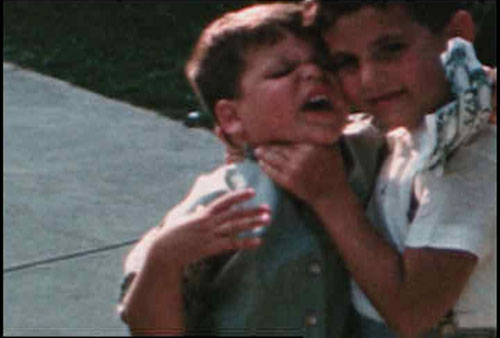
The film shifts back and forth between the faded color of a Super-8 home movie and "found" scenes in black and white -- a little boy lying in bed, a child's belly being examined by a doctor's hands. The scenes from childhood are cut by black screens with written pieces of narrative like: "My little brother died when I was 9 years old." "He had been sick for 2 years" "He was six years old and my parents had to push him in a stroller." "I was embarrassed by him." "I made fun of him." The narrative appears and disappears over a simple, hesitant piano line (Arvo Pärt's Für Alina) filled with silences. The first voice heard is the voice of authority: another doctor demonstrates the perfectionist ritual of peeling a pair of surgical scissors out of a sterile wrapping. The narrative line continues with poignant irony: "He died from an infection after surgery," and with the child's explanation: "I thought my teasing and resentment had caused his death."
In the "found" film clips, a boy is shown bullying other boys at kindergarten. A mother and father are sitting stiffly in a fifties living room, reading. A boy lies in the foreground on the rug. He looks up at the camera with an expression as hard to read as that of the muted parents – there is pain, smoldering anger and fierce withdrawal in his eyes. The inter-title reads: "Suffering was the last way my parents could love their child." The lively, pleased-looking little brother appears for one last close-up and the conclusion to this first segment: "Decades have past since my brother died and we still don't talk about him."
For a start, this first history of loss almost resembles straightforward story telling about a family's despair and the surviving brother's guilty turmoil. But the separation into distinct formal elements sets it apart from a traditional narrative. There are the elements of a silent (speechless?) movie. Through the inter-titles and the subtle musical accompaniment the story is given space for thought. It is allowed to think, free-associate, reflect on itself. In the wake of the home movie clips, the "found" stories only seem to illustrate the autobiographical story. Moreover, each archival story brings in a different boy to stand in for the filmmaker himself. Instinctively and creatively, one's mind sets to work to make them fit, working hand in hand with the filmmaker to create the narrative. By reconnecting the separate boys, by overcoming the "distanciation" of Rosenblatt's device, we are tied intimately into the story telling. By making each different boy identifiable, we unwittingly find ourselves more closely identified.
I am reminded of E.W. Forster's comments on art: "The Arts are not drugs. They are not guaranteed to act when taken. Something as mysterious and capricious as the creative impulse has to be released before they can act." It is the great achievement of Rosenblatt's art to bring about this participation/collaboration in the audience, and to do it from the very first image, consistently.
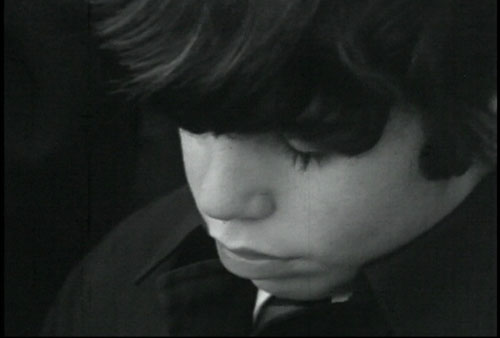
In the second segment, Collapse, the music shifts to a slow, sad orchestra piece (Silovan's Song, another exquisite composition by Arvo Pärt) while on-screen one building after another silently falls. Again my own reflection rushed to the task, comparing the literal with the metaphorical. I know that it is common for children who have experienced early loss to be psychically hooked into exactly this image of a world falling apart. But the scenes Rosenblatt chose from archival footage exert an independent fascination: the strange, dreamlike slowness with which the seemingly solid, high buildings suddenly separate themselves from their neighbors and, while they still keep their whole vertical shape for a moment, start sinking into themselves, until the top floors topple like a waterfall into the clouds of dust rising from below.
While I was mesmerized, wanting to see it happen over and over again, for some audience members, this was already too much. They were puzzled why so many houses had to fall. The film had hardly begun and, already, gone over the edge?
The 12 sections of Phantom Limb unveil what grief over a child's death is made of: 1. Separation, 2. Collapse. 3. Sorrow. 4. Denial. 5. Confusion. 5. Shock. 7. Rage. 8. Advice. 9. Longing. 10. Depression. 11. Communication. 12. Return. The sections recall Elisabeth Kübler-Ross and her 5 stages of people's emotions when they know they are going to die (denial, anger, bargaining, depression, acceptance.) Even stronger was the association to the 12 Stations of the Cross, although Rosenblatt does not follow them literally. The movement of the film through these stations feels like someone walking slowly, deeply in thought. Scenes from a funeral procession from the forties or fifties show a crowd of mourners in "3. Sorrow." The only sound is a bell that tolls. The camera lingers on the faces of women and men in the crowd. Many of them are overcome, some are crying. A different kind of procession picks up the theme in "10. Depression": Hundreds of worn-out men shuffle in line toward food or some other form of relief. Other men seem unable to walk any further.
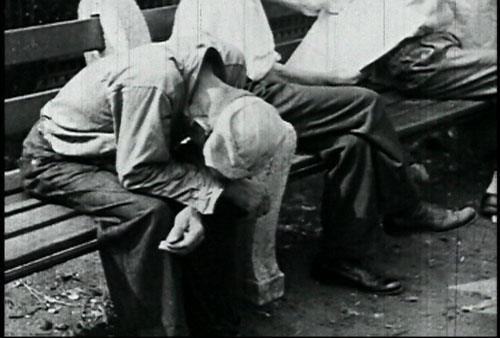
The simple literalness of these scenes is deceptive. In fact, the filmmaker removes us from the story – his story – and again, makes room for reflection. In this way, once removed, we can fill the universal images and scenes with our own content. Emotions like sorrow or depression can be felt precisely because Rosenblatt addresses them "askance" in this way.
The same intent seems to feed into Rosenblatt's use of "found" stories throughout the film. His montage not only finds moments and faces that stir up emotion, the very fact that we are looking at the past, across the distance of time, creates a haunting of memory. It is as if these scenes open a gate to the unconscious, allow one to slip through and relive the emotions of the past, of childhood. Once seen, one can't forget the film. The images have entered and begun to stir up the archetypal experiences from one's own life. At the same time, within the movement of the whole film, the simplicity of these sections has the effect of a silence before the storm, a contemplation before an upheaval.
In 6. Shock, two rats in a cage are given electro shocks while the voice of a scientist explains what we see: jolted, the rats race around in "escape behavior," but when they discover that there is no escape they both rise to the attack, trying to reach each other with their front paws, almost nose to nose, menacing to bite, shrieking with each shock. 7. Rage appears to be another "learning film". A boy in preschool is unhappy for no apparent reason. He doesn't want to play any more. He cries. The other children take no notice. The teacher announces that it is time for the chair. The boy cries harder. He goes to sit on a chair with his back to the room, bawling. "If you cannot play and be nice, sit there five minutes," the teacher decrees. "Five minutes. When you stop crying." "No!" the boy shrieks and shakes with the intensity of his protest.
I sensed the division in myself – relief that someone on-screen was releasing pain by screaming with rage, and eagerness to make the boy shut up. It was a division between raw emotion and repression or, one could also say, a struggle between child self and adult self. Both segments are painful to watch as they bring home to us the helplessness that comes out of our own ambivalence toward feeling pain. This ambivalence stirred up the audience at the festival screening. A few protests and shouts of "Enough already!" could be heard. Perhaps the filmmaker had anticipated that by now the spectators would feel trapped like rats and threaten to turn their pain against him. The next station pretends to be soothing by providing "Advice."
"Know that you will survive." "Know that you are not alone," a woman's gentle voice encourages us over the sad, cradling rhythm of Arvo Pärt's violin composition Silentium. While her voice helps grieving parents cope with the death of their child, Rosenblatt's camera is focused on a sheep shearer in a darkish barn. The man in blue work pants holds the sheep between his legs. He moves the comb-shaped electric shears over the body of the sheep. The man works steadily and methodically, adjusting and positioning the body of the sheep as he goes. Flocks and mats of wool fall away. "Keep in mind that grief does not proceed in orderly predictable stages." "Be prepared for the enormous effort it will take to have a normal, mundane conversation." "Cry." Inexorably, the naked, whitish-pink skin of the sheep is revealed. "Prepare to answer the question: How many children do you have?" Sometimes the shears go over an already stripped area of the sheep's body and cut even closer to the skin. "Go easy on people who say stupid things such as: At least you had her as long as you did. You can always have another child. You'll grow so much stronger through this. I know how you feel. It's God's will." The sheep quietly rests against the man. He is masterful in his work. His hand sometimes passes over the animal's head with something like tenderness. "Don't expect the pain to ever fully go away." The sheep trusts his every movement, like a child.
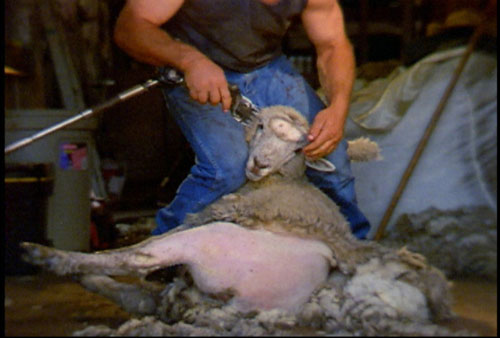
At this point in the film, an energy shift happens. The final stage of Kübler-Ross' emotional struggle, acceptance, comes into view as a possibility. At the same time, because of the metaphor of the "sacrificial lamb," this scene is the closest parallel to the Stations of the Cross, inviting us to feel the vulnerability which we never outgrow while life and death handle us. The long process of watching the sheep being shorn shifts back and forth the possibility of identification with the sheep, with the dead little boy, with the older boy who has been shorn of his brother.
In 10. Longing,a middle-aged man talks to Rosenblatt's camera about the sensation of "phantom limb." Apart from missing his right arm it is not clear how many limbs he has lost in an accident. The hardest thing, the man says, is that he can't really hold his daughter like a normal person. All of a sudden it dawns on one that perhaps the sensation of phantom limb is the pain of longing. Maybe this is what Rosenblatt implied in station 1, "Suffering was the last way my parents could love their child."
The last scene in the twelfth section, Return, shifts to a baby station at some ward or hospital. On a huge table hundreds of newborn babies wiggle and stir. Some are wrapped in white cloth, some are in diapers; those in the foreground are naked. Some sleep, some cry, others seem to search for something to suck on. Nurses are shaking baby powder rather randomly over the naked bodies. The mass of babies made the audience laugh with disbelief. The scene made me think of a war effort, a refugee camp or some other massive health crisis from the past. The camera zooms in on two babies in the front row who are turned toward each other. In their need for human comfort, for something to touch, something to mouth on and suck, these two have found each other. For a second, attempting to eat each other up, they appear almost as frantic as the two rats pawing each other in their electrocuted cage.
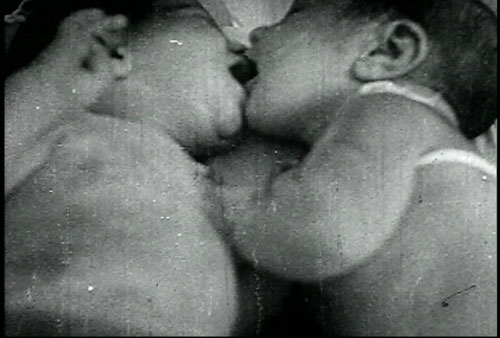
Once again, there is no explanation. Many ambiguous words and feelings shot through me while watching this scene – "mass resurrection", brothers, nurture, tenderness, hope, despair, helpless, hunger, hopeless, eternal bond...
The next close-up – and the final screen image – is that of a single, more peaceful baby. This final clip recalls the last, single image of the little brother when he was still alive.
I watched Phantom Limb a number of times, trying to figure out how Rosenblatt's method works. As each segment or station is named and the inter-titles appear, what we expect from the words is ambiguously met by what we see. The titles give us hints about a direction of thought, an intended meaning, but one's mind is busy gathering clues, trying out interpretations, making comparisons. In this process the mind seems to disarm its own defenses against feeling. We continue to mysteriously build connections as the film unfolds, finding ourselves feeling more than we expected to feel or usually allow ourselves to feel. The formal ideas and aesthetic devices Rosenblatt uses have a radical impact on precisely those feelings our culture busily covers up and helps us avoid. I call this accomplishment state of the art – for film or any other art.
The Jewish Film Festival's inclusion of Phantom Limb showed an applaudible commitment to film as art, and I would have expected the Berkeley spectators (mostly women) to be an ideal audience for the film because of their personal and communal stake in loss and mourning. In the Q and A session, however, audience members complained about the sheep and the rats. One person wondered whether this wasn't just a very personal and therefore rather limited take on loss – holding up the mirror in which the artist is asked to see his reflection as a fool. Under this onslaught Jay Rosenblatt appeared as a handsome man of a slight, wiry build who answered in a shy voice, with knowing eyes and a reserved smile, perhaps finding a note of humor in the ordeal. He is a teacher after all. He must know that his unsettling, edgy, daring films, like Phantom Limb, provoke the feelings most of us would rather not know.
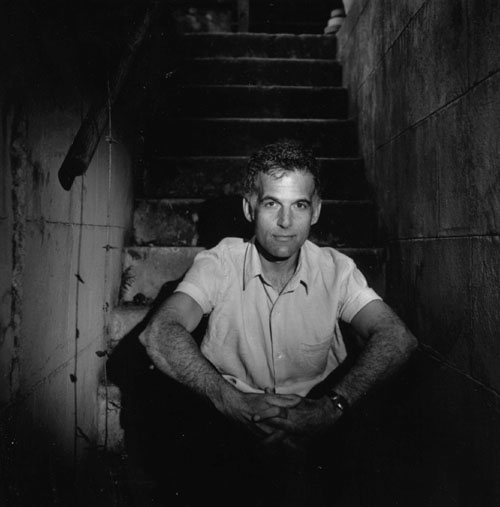
Jay Rosenblatt's films can be purchased or rented at www.jayrosenblattfilms.com
Renate Stendhal is an author and critic
©2005 Renate Stendhal
©2005 Publication Scene4 Magazine
|
|